Some, like Mozart or Sid Waddell, are born as geniuses. Others have genius thrust upon them, in the form of a single brilliant, radical idea. And the very best sort of brilliant, radical idea is the one that appears so obvious that it’s hard to believe that nobody had thought of it before. Henry (‘Harry’) Charles Beck (1902-1974) was the recipient of such a stroke of genius, for he was the man who made the Tube comprehensible.
The first underground line in London was the Metropolitan Railway, running between Paddington and Farringdon Street via King’s Cross. It opened in January 1863 and within a few months was carrying over 26,000 passengers a day. The Hammersmith and City Railway was opened the following year and by the early 20th Century there were six independent, rival operators running different underground lines. But the lack of integration caused all sorts of bother for commuters and in 1908 the operators attempted to boost passenger numbers by jointly presenting themselves as ‘the Underground’ and bringing out a free publicity map of the ‘network’.
The 1908 map looked like this (click for a larger image):
Geographically accurate, beautifully drawn… and a bloody headache, especially in Central London, where the stations are crammed together much more closely than in the outer regions. This 1922 map, exquisitely rendered by graphic artist MacDonald Gill, suffers from the same problems:
In the 1920s Beck was working as an engineering draftsman at the London Underground Signals Office. His great insight was that passengers didn’t really give two hoots about geographical accuracy, merely how to get from one station to another, and where to change. And he used the skills he’d developed in drawing electrical diagrams to conceive the idea of the simple ‘circuit’-style design. All of this he did in his spare time – in other words, he Dabbled the Tube map into being.
He submitted the idea to the London Underground in 1931, but it was initially rejected for being too radical and for failing to indicate the distances between stations. But a successful trial run of 500 maps was eventually printed, and an instantly-popular full publication of 700,000 copies was introduced in 1933. It looked like this:
Beck continued to work on updates of the map as a freelance, but he faced competition from rival mapmakers Harold Hutchison and Paul Garbutt (a Nick Park film is just waiting to be made about the three obsessives and the ‘map wars’ isn’t it?)
Beck’s maps and the modern versions are design classics – beautiful as well as practical (or perhaps the beauty lies in the simple practicality?) and have been copied around the world – but not, alas, closely enough by the French. Observe the Paris Metro map, with its nauseating hexagons and unwise geographical approximations. Is this a rare instance of the French being too fixated on the real? The French, lovers of the abstract and the ephemeral, fail to create something useful by attempting to represent reality. The down-to-earth British, on the other hand, embrace the abstract to create something practical. We might have to consult Dr Dylan Trigg on that one.
Incidentally, one interesting consequence of Beck’s genius is the effect of his map on the ‘psychogeography’ of London. Visitors and even locals who primarily get around by Tube can have a completely distorted view of the layout of the capital. It’s common for tourists to make complicated journeys by Tube which would take no time at all on foot. This is what the Tube map would look like if it represented physical reality:
And here you can watch Beck’s 1933 map morph into a modern map and a geographically accurate one.

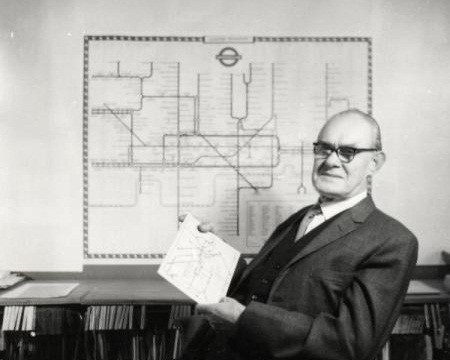
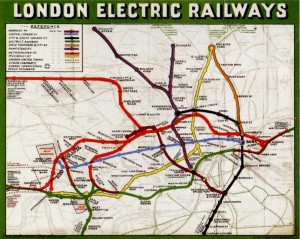
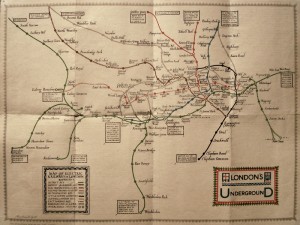
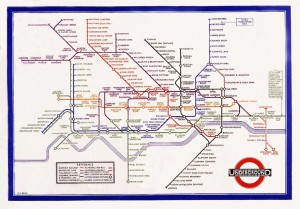
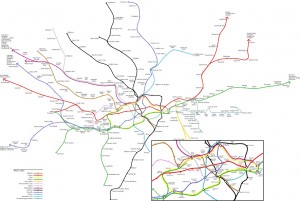










Definately one of my favorite pieces of design work. Incidentally, are you aware of the artwork on display at Tate britain that uses this design? it’s called The Great Bear by Simon Patterson and it’s not really that exciting
Yes I bought a print of The Great Bear about 12 years ago, but as I said over at Think of England, I think now I’d rather just have the real Tube map on the wall…
must have been about 12 years ago that I bought my copy too!
Fools seldom differ, eh, Worm…
He is the patron saint of draughtsmen, don’t you know.
Has anyone taken their appendix out on the Piccadilly line?
Arguably, any journey within the centre is better by foot.
I think you’re a little unfair to the Paris Metro map (‘nauseating hexagons’) which I use constantly and which gets me where I want to go with a minimum of problem. And the actual service, of course, is pretty good too. But Beck is a true hero: he must be turning in his grave as regards the grotesque apology for a public transport system that the Tube has become.
Maybe you’re just more tuned in to ways of the French brain, J.
I find the Tube is a brilliant transport system except when it’s a bloody awful one.
At least the Tube hasn’t attained the grotesqueness of the NY Metro. What a dump. In fact, on a recent trip I was struck at the scale of the liability the US has built up in its public infrastructure – and with no prospect of any significant capital spending on it for the foreseeable future. The PPP might be a swiz but at least we are investing.
Brit, Harry is a dead ringer for Sid Waddell; he could be his father. I suspect there’s a clue in the opening of his pitch to the Board of the London Underground Company in 1931: “Wor, bonny lads, me map’s got more straight lines than the Battersea Ruler Company”. Claims that Harry was born in Leyton and not Gateshead should be approached with some scepticism.
I saw the Great Bear map for the first time a few weeks ago and wondered what’s the point of that? “Cockfosters” and “Baron’s Court” and “King’s Cross” mean a lot more on a map than “Spinoza” or “Karl Marx”. The tube map looks glamorous to me as it has the whole excitement and buzz of visiting London – a great city and one I see as a foreigner. The tube map is like the Eiffel Tower or the Manhattan skyline, I am either whisked around the Underground by a friend who lives there and so taken on a journey where I can’t get my bearings at all, or I’m by myself in a half-lost foreign fog trying to work out all the lines and changes.
I read a piece about London after the 7/7 bombings written by an Irish guy who said what struck him was the Londoners instantly re-considering routes – discussing having to go by the Circle as the Piccadilly line was closed. That was their London instinct.